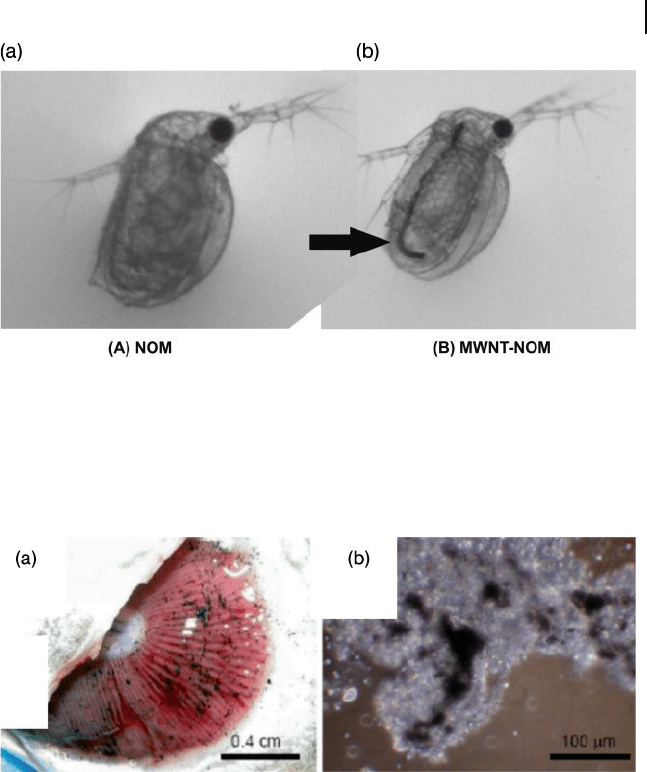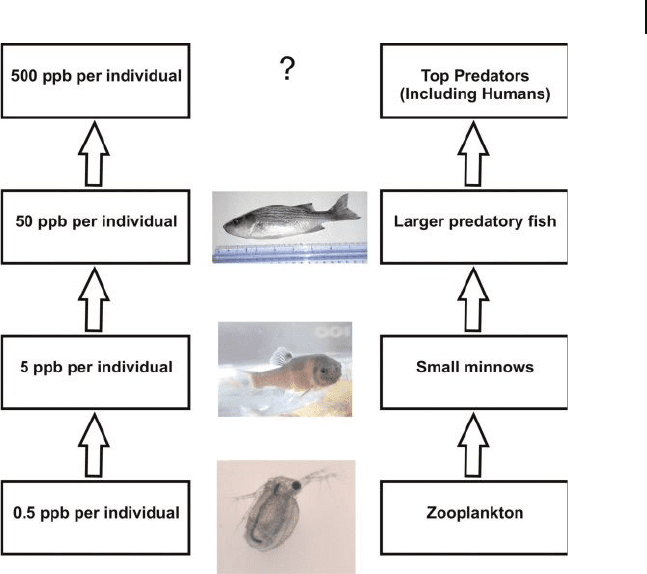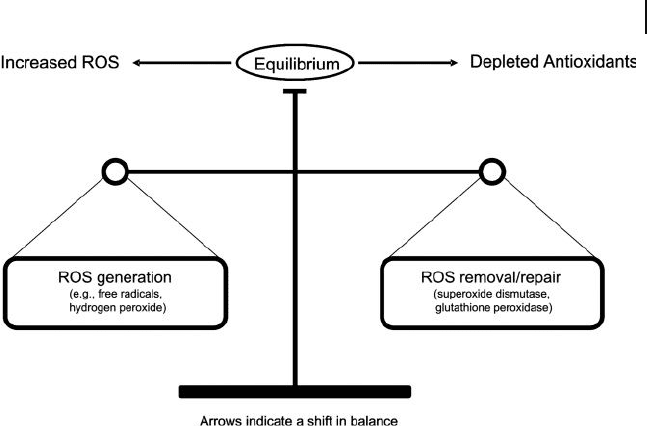Geckeler K.E., Nishide H. (Eds.) Advanced Nanomaterials
Подождите немного. Документ загружается.


18.2 Fate and Exposure 599
with another smaller species ( Ceriodaphnia dubia ) using natural organic matter -
stabilized multiwalled CNTs (Figure 18.3 ).
The dietary uptake of single - walled CNTs has also been reported in estuarine
copepods ( Amphiascus tenuiremis ), another zooplankton species [18] . Also reported
here was the presence of compact aggregations of nanotubes in the fecal pellets
of the copepods. Fewer studies exist on the uptake of nanotubes by fi sh; in rainbow
trout, nanotubes ingested from the water column were shown to adhere to the
mucous secretions of the gill tissues (Figure 18.4 ) [19] .
Figure 18.3 Micrographs of the zooplankton Ceriodaphnia
dubia , following exposure to (a) natural organic matter and
(b) natural organic matter and multiwalled carbon nanotubes
(MWCNTs). The dark line visible inside the organism in panel
(b) is the intestinal tract (arrow), containing large amounts
of MWCNTs.
Figure 18.4 (a) Single - walled carbon nanotubes adhered to
the mucous secretions around the gills of rainbow trout;
(b) Phase - contrast micrograph of a mucus smear, showing
nanotubes associated with the mucous proteins. Reproduced
from Ref. [19] .

600 18 Ecological Toxicology of Engineered Carbon Nanoparticles
However, it is unknown what fraction (if any) of the nanotubes crossed the epi-
thelium and were taken up into the soft tissues of the organisms in any of these
studies, although this is largely due to a lack of effective methods for measuring
nanotubes at the low concentrations found in biological tissues. The limit of detec-
tion for analytical methods requires samples to be concentrated to such a high
degree that there may be great uncertainty in the accuracy of their determination.
Fullerenes and some fullerene - derivatives are known to be lipophilic [20] . Fuller-
enes are easily extracted from tissues using organic solvents, and their concentra-
tion determined using spectrophotometry. In one study, Oberdorster et al . [21]
documented an increasing uptake of fullerenes by zooplankton from the water
column over a 96 h period [21] . It has been suggested that adding functional groups
to both fullerenes and nanotubes decreases their toxicity in vitro [22 – 24] , though
this may be due to alterations in the hydrophobicity and thus uptake of the mate-
rial by cells [24] .
18.2.4
Tissue Distribution
Once internalized by the organism, chemical contaminants are distributed to the
tissues via the circulatory system. Again, there is a paucity of data regarding the
tissue distribution of carbon nanoparticles in aquatic organisms. Oberdorster et
al . [21] found that exposure to uncoated fullerenes resulted in an increased oxida-
tive stress in the brains of largemouth bass, leading to the possibility that the
materials were able to cross the blood – brain barrier [11] . These results were sup-
ported by another study, in which the distribution of fl uorescent, nanosized poly-
styrene spheres in the tissues of the medaka, an aquarium fi sh commonly used
in aquatic toxicological studies, was investigated [25] . Kashiwada [25] found that
fl uorescing polystyrene nanoparticles accumulated within the gut and gills of the
fi sh, and were also detected in the brain, testis, liver, and blood. However, the
most intense fl uorescence was observed in the gill tissues, indicating that uptake
across the gill epithelium may be a major route of exposure. A previous study had
shown that rats dosed orally with fullerenes excreted most of the material via the
feces, whereas rats injected intravenously with fullerenes retained the materials
for over one week, with the majority being distributed to the liver [26] . These fi nd-
ings support the hypothesis that, in fi sh, uptake across the gills may be a more
important route of exposure than dietary ingestion.
18.2.5
Food Web
Several chemical compounds found in the environment – and especially those
which are not easily metabolized, such as mercury and polychlorinated biphe-
nyls – have been shown to move through aquatic food chains [27 – 29] . These materi-
als are taken up by organisms at low trophic levels such as bacteria, algae, and
zooplankton and, because they are not easily metabolized and excreted, are passed

18.2 Fate and Exposure 601
on to higher trophic levels when those organisms are subsequently ingested by
predators. This results in increasing concentrations of chemical within organisms
at higher levels of the food chain, a process known as biomagnifi cation (Figure 18.5 ).
The biomagnifi cation of these materials can pose signifi cant risks to the health
of organisms located at higher trophic levels which might otherwise not be exposed,
including humans [30 – 34] . For example, mercury consumption warnings in
seafood are a result of biomagnifi cation of methyl mercury through the food web.
Studies conducted by Templeton et al . [12] and Roberts et al . [18] have indicated
that zooplankton in aquatic systems can ingest nanoparticles from their environ-
ment through normal feeding behavior. Bacteria, which form the bulk of aquatic
biofi lms, have also been shown to take up nanosized particles. Both, biofi lms and
zooplankton occupy lower trophic levels in aquatic ecosystems and provide an
important food base for a variety of organisms, including fi sh. Considering the
lipophilicity of some nanoparticles, and the lack of evidence of true metabolism,
the potential for biomagnifi cation clearly exists.
Figure 18.5 Biomagnifi cation through an aquatic food chain.
Contaminants may be found at relatively low concentrations
at lower trophic levels (zooplankton). Concentrations will
increase as predatory organisms consume large numbers of
prey items, but do not have the ability to metabolize or
excrete the chemical contaminant.

602 18 Ecological Toxicology of Engineered Carbon Nanoparticles
18.2.6
Effects on the Uptake of Other Contaminants
Due to the relative ease with which some engineered carbon nanoparticles are
taken up by cells, there is also concern regarding the potential for these materials
to facilitate the transport and uptake of other, adsorbed chemical contaminants
into cells. Polycyclic aromatic hydrocarbon s ( PAH s) are a ubiquitous contaminant,
and are discharged into the environment as a result of the incomplete combustion
of fossil fuels. They are generally considered to be carcinogenic and to have a range
of toxic effects [35 – 37] . Yang et al . [38] showed that PAHs readily adsorb to fuller-
enes and nanotubes [38] , while Moore et al . [9] also found that coexposure to a
model PAH (anthracene) and a nanosized polyester sucrose particle increased
both the uptake and cellular toxicity of anthracene in mussels. Contaminants
which are readily adsorbed onto carbon nanoparticles, or are closely associated
with them as a result of manufacturing processes (such as transition metals), may
be delivered more rapidly to cells in the presence of nanosized particles.
18.3
Effects
18.3.1
General
The limited data relating to the toxicological effects of engineered carbon nano-
particles has derived from research groups that have focused largely on mamma-
lian models (both in vitro and in vivo ). Such studies have been carried out primarily
to determine whether these compounds cause, or have the potential to cause,
human health effects following occupational exposure. Although there are excep-
tions, the bulk of the data suggests that engineered carbon nanoparticles are toxic
to some degree, and points to oxidative stress, infl ammatory reactions, and immu-
nological effects as the key features of carbon nanoparticle toxicity [39, 40] .
Relatively few studies, however, have been carried out regarding nanotoxicologi-
cal effects on ecologically important aquatic species, such as fi sh and zooplankton
(Table 18.1 ). The aim of this section is to summarize and review the ecotoxicologi-
cal effects of engineered carbon nanoparticles, focusing primarily on aquatic
eukaryotic systems (e.g., fi sh and zooplankton), as has the bulk of reports made
to date.
18.3.2
Oxidative Stress and Nanoparticles
Aerobic organisms use oxygen to oxidize (burn) carbon - and hydrogen - rich sub-
strates (foods) to obtain the chemical and heat energy that is essential for life.
However, when molecules are oxidized with oxygen, the oxygen molecule itself

18.3 Effects 603
Table 18.1 Summary of the ecotoxicological literature on nanoparticles.
Reference Species Nonmaterial
tested
Preparation
method
Concentrations
tested
Endpoints examined
[11] Micropterus salmoides nC
60
THF 0.5 – 1.0 ppm Lipid peroxidation, protein oxidation, glutathione
[21] Daphnia magna
Pimephales promelas
Hyalella azteca
Oryzias latipes
nC
60
Water - stirred 0.5 – 30 ppm Mortality, CYP P450 isozymes, PMP70
[41] Daphnia magna nC
60
Sonication
THF
0.2 – 880 ppm Mortality, behavior
[42] Daphnia magna
Pimephales promelas
nC
60
Water - stirred
THF
0.5 ppm Lipid peroxidation, CYP2K1, CYP2M1
[42] Stylonychia mytilus MWCNT AEDP
0.1 – 200 μ g ml
− 1
Cytotoxicity cell morphology, structural alterations
[43] Danio rerio nC
60
nC
70
nC
60
(OH)
24
DMSO
DMSO
DMSO
100 – 500 ppb
100 – 500 ppb
500 – 5000 ppb
Development effects, apoptosis

604 18 Ecological Toxicology of Engineered Carbon Nanoparticles
Reference Species Nonmaterial
tested
Preparation
method
Concentrations
tested
Endpoints examined
[44] Bacillus subtilis
Escherichia coli
nC
60
nC
60
(OH)
22 – 24
THF
0.04 – 4 mg l
− 1
5 mg l
− 1
Growth
[45] Danio rerio nC
60
Stirring and
sonication
THF
Dilution of stock
solution
Mortality, behavior, global gene expression
[12] Daphnia magna SWCNT - lipid
coated
LPC
2.5 – 20 mg l
− 1
Mortality
[42] Danio rerio nC
60
nC
60
(OH)
16 – 18
Acetone/benzene/
THF
water
1.5 mg l
− 1
50 mg l
− 1
Mortality, developmental effects, hatching rate, heartbeat,
pericardial edema
[19] Oncorhynchius mykiss SWCNT SDS, sonication
0.1 – 0.5 mg l
− 1
Behavior, gill ventilation rates, plasma ions, histopathology,
Na
+
K
+
- ATPase, oxidative stress
[46] Daphnia magna nC
60
nC
20
HxC
20
Hx
THF 260 ppb Behavior
THF, tetrahydrofuran; AEDP, 2 - Amino - ethyene - l,1 - bis - phosphonic acid; LPC, lysophophatidylcholine; SDS, sodium dodecylsulfate.
Table 18.1
Continued.

18.3 Effects 605
becomes reduced and forms intermediates called reactive oxygen species ( ROS );
these include free radicals and hydrogen peroxide. Oxidative stress is the term used
to describe the level of oxidative damage in a cell or tissue caused by ROS, the
latter being a class of molecules that are derived from the metabolism of oxygen
and which exist inherently in all aerobic organisms. In fact, ROS are produced
constantly during normal aerobic metabolism, but are normally safely removed by
a variety of biological antioxidants, such as superoxide dismutase ( SOD ), catalase,
or glutathione (GSH) peroxidase. The amount of oxidative stress in a cell or tissue
can be thought of as a balance between the overall generation and the overall
removal/repair of ROS by antioxidants (Figure 18.6 ). Therefore, oxidative stress
within a cell or tissue can result from two factors: (i) an increase in oxidant genera-
tion; and/or (ii) a decrease in antioxidant protection.
Research has shown that xenobiotics such as metals and hydrocarbons can shift
the oxidative stress balance, thus causing an overproduction of ROS or the inhibi-
tion of antioxidant systems [47 – 49] . This shift in balance leads to excessive molecu-
lar damage and tissue injury, an example being lipid peroxidation. The latter
process is defi ned as the free - radical oxidation of polyunsaturated fatty acids in
biological systems, and can be used as an end - point to measure oxidative stress.
The most common biomarkers used to measure oxidative stress include thiobar-
bituric acid reactive substance s ( TBARS ), which measures the presence of lipid
Figure 18.6 Oxidative stress occurs naturally, but biological
systems maintain an equilibrium by counteracting the
deleterious effects of reactive oxygen species ( ROS ) with
antioxidants. Increased oxidative stress, a common mode of
action for a number of chemical toxicants, can occur through
either a depletion of a biological system ’ s antioxidants or an
increase in the number of ROS.

606 18 Ecological Toxicology of Engineered Carbon Nanoparticles
peroxides and the reduction of GSH, an antioxidant which occurs naturally within
cells and is known to scavenge ROS [49 – 52] .
The majority of mammalian - based reports point to oxidative stress as the main
mode of action of engineered carbon nanoparticles (e.g., Ref. [40] ), and so the
assumption is typically made that this is the main mode of action in all species.
With the exception of one report [11] , the present authors are unaware of any other
ecotoxicological literature providing evidence that exposure to engineered carbon
nanoparticles results in oxidative stress. These examinations provide insight into
the possibility that carbon - engineered nanoparticles may affect aquatic organisms
in a different way from mammalian systems. For example, Roberts et al . [12] have
suggested an energetics mechanism and interference with normal feeding behav-
ior in zooplankton.
One major issue which concerns all toxicological studies is to ensure that any
observed effects can be attributed to the compound of interest, and not other con-
founding factors. This is of particular concern when using organic solvents to either
solubilize or stabilize a material in aqueous media. Some carbon nanoparticles,
including C
60
, have a very low solubility in water; consequently, organic solvents
have been used (notably tetrahydrofuran ; THF ) to increase the solubility of engi-
neered carbon nanomaterials. In the fi rst report addressing the question of whether
exposure to engineered carbon nanoparticles would result in ecotoxicological
effects, Oberdorster [11] used THF to create nC
60
solutions for exposure to large-
mouth bass. These preliminary study results indicated that nC
60
caused signifi cant
lipid peroxidation in the brains of the exposed fi sh, since which time the preparation
of nC
60
using THF has become common practice. However, data obtained by Henry
et al . [45] indicated that, at least in zebrafi sh, observable toxic effects could be attrib-
uted to THF and its breakdown products, as opposed to fullerenes [45] . Although
the exact mode of action of THF - prepared nanoparticles is unknown, it has been
suggested that THF might cross the cross the blood – brain barrier, unlike carbon
nanoparticles [53] , thus explaining the fi ndings of Oberdorster [11] .
It is also important to note that not all mammalian - based data have pointed to
oxidative stress as the toxic mode of action of carbon nanoparticles. In fact, it has
been suggested that nC
60
may function in an opposite manner, and act as a free -
radical scavenger [53] . An in vitro experiment in rats investigated the antioxidant
effect of nC
60
by pretreating rats with nC
60
, followed by an injection of carbon
tetrachloride (CCl
4
), a chemical which is known to cause oxidative stress in the
liver [53] . The study results showed that nC
60
protected the liver against oxidative
stress, which led the research team to conclude that the mechanism behind the
protective role of nC
60
could be attributed to the ability of nC
60
to scavenge large
numbers of free radicals.
18.3.3
Effects on Specifi c Tissues
18.3.3.1 Brain
The brain is arguably the most complex organ of all organisms, and may be incred-
ibly sensitive to insult, with any disruption or interference with correct brain

18.3 Effects 607
functions possibly leading to a loss of fi tness and/or death. Although the effects
of engineered carbon nanoparticles on the brain are poorly understood, behavioral
changes in multiple aquatic species exposed to engineered carbon nanoparticles
have been observed and have provided evidence that these particles might impair
normal brain function [19, 46] . For example, when Smith et al . [19] exposed
rainbow trout ( Oncorhynchus mykiss ) to single - walled CNTs, they observed aggres-
sive behavior in the exposed fi sh that led to severe fi n nipping. Although no bio-
chemical changes were observed in the brains of these fi sh, a histological analysis
identifi ed what appeared to be aneurysms (swelling of the blood vessels), which
indicated that the blood supply – and hence the oxygen supply – of the brain may
have been compromised. Behavioral effects were also observed in Daphnia magna
after exposure to nC
60
[41, 46] . In these studies, both juvenile and adult D. magna ,
when exposed to nC
60
, showed an abnormal behavioral response to the exposure
that resulted in sporadic swimming and disorientation.
Following initial studies conducted with mammalian cell lines, the investigations
into the toxic mode of action focused on oxidative stress [5] . As noted above, Ober-
dorster [11] had suggested that nC
60
could be selectively transported to the brain,
where it would cause toxic effects; this idea was based on the signifi cant increase
in lipid peroxidation that had been shown in the brains of largemouth bass exposed
to nC
60
. Unfortunately, these results, and their subsequent interpretation, may have
been compromised by the use of an organic solvent in the experiment.
18.3.3.2 Gills
In fi sh, the gills function in similar fashion to the lungs in mammals, and are vital
not only as the main site for gas exchange but also as an important component of
ionoregulation. Carbon - engineered nanoparticles, based on their size and chemi-
cal properties, have the potential to cause harm in both a physical (e.g., abrasions)
and chemical (e.g., disruption of gas exchange) manner. A study conducted by
Smith et al . [19] documented increases in both ventilation rate and mucus secre-
tion, as well as an enlargement of mucocytes on the gills of trout exposed to single -
walled CNTs. This led the authors to conclude that the CNTs had clearly caused
respiratory distress. Interestingly, the trout had responded to the exposure by
increasing a natural defense mechanisms, namely an increased mucus secretion.
This reaction is common in fi sh exposed to aqueous pollutants [54] , and is a short -
term defense mechanism designed to prevent the toxicant from reaching the sensi-
tive gill epithelium [19] .
18.3.3.3 Liver
In higher - level organisms, such as fi sh (and humans), the liver performs the
enormous duty of maintaining the metabolic homeostasis of the body. Its respon-
sibilities include protein synthesis, nutrient homeostasis, and the fi ltration of
particulates. The liver is also the main location for the detoxifi cation of toxicants
and is, therefore, susceptible to chemical exposure and toxicity. Results obtained
from studies in mammals have shown that intravenously administered fullerenes
can be retained in the body for up to one week, with the majority ( > 70%) lodging
in the liver [26] .

608 18 Ecological Toxicology of Engineered Carbon Nanoparticles
Whilst the potential effects of these compounds on correct liver function are
relatively unknown, Smith et al . in 2007, observed apoptosis (programmed cell
death) in the liver of trout following their exposure to single - walled CNTs. Although
the exact toxic mode of action was unknown, the location of the injured liver cells
(close to the blood vessels) raised concern that the nanoparticles were being deliv-
ered systemically via the blood supply [19] .
18.3.3.4 Gut
In theory, the gut would be expected to serve as the main site of uptake for nano-
particles associated with dietary exposure and drinking water. As noted earlier in
the chapter, carbon - engineered nanoparticles are potentially bioavailable and can
enter an organism via a number of pathways, including the ingestion of food and
water. Although, observations have been made of carbon nanoparticle aggregates
in the gut lumen of fi sh [19] and zooplankton [12] , the bioavailability of these
aggregates and their potential to cross the epithelial lining is largely unknown, as
discussed previously.
18.3.4
Developmental Effects
Organisms are typically the most sensitive to insult (chemical or physical) during
their early development and in the early life stages. Chemical compounds
may disrupt cellular signaling, alter apoptosis patterns, or damage DNA, thus
causing organisms to develop abnormally ( teratogenicity ). Teratogens can result
in obvious effects such as physical deformities, or in more subtle changes such
as behavioral abnormalities. These changes early in life can have profound effects
on the ecological fi tness of individuals, and result in deleterious population - level
outcomes.
A host of investigations have utilized zebrafi sh embryos when investigating the
developmental effects of engineered carbon nanoparticles [42, 43] . For example,
Usenko et al . [43] observed delayed development, morphological malformations
(e.g., of the body axis, eye, snout, jaw, otic vesicle, notochord, heart, brain, somite,
and fi ns), pericardial edema (Figure 18.7 ), yolk sac edema (Figure 18.7 ), and
behavioral abnormalities (e.g., hyperactivity, hypoactivity, paralysis) in fi sh exposed
to nC
60
. Of particular interest in this study was the constant abnormal development
of the fi n regions in all exposed organisms, which was indicative of cell signaling
perturbations during early development (Figure 18.7 ). In another study, Zhu et al .
[42] found that hatching rates in nC
60
- exposed zebrafi sh embryos showed notable
developmental delay and toxicity, slower heart rates, and increased pericardial
edema.
The developmental effects such as those observed by Usenko et al . [43] and Zhu
et al . [42] may have far - reaching implications since, in nature, individuals that
experience abnormal development rarely survive to reproduce. Therefore, com-
pounds found to cause developmental effects have the potential to affect entire
populations and communities, and thus deserve special attention.
